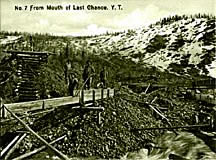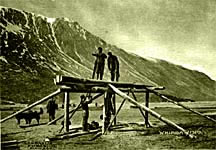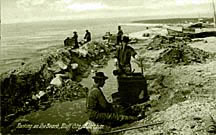 III. Themes to Guide Discussion and Work
III. Themes to Guide Discussion and Work
Excitement and Wealth: Though students can argue about this, the Klondike gold rush was probably the most momentarily exciting event in the Northwest in the 19th century. People really got quite crazy. The documents provide a way for students to investigate this excitement. Why was this event exciting? What were people excited about? What factors contributed to the excitement, and who worked to increase or decrease it, and why? How was the gold excitement related to the larger economic and social context of the Pacific Northwest in the late 19th century? What happened to that excitement as the gold rush progressed? How did it change?
The question of the Klondike excitement is of course connected to gold and to the promise of wealth that went along with gold. The Klondike gave people a chance, or so they thought, to get rich. That promise of riches is something that students can debate. Why did/do people want to get rich? What options did they have in 1898? Why was this such an attractive option? Why did everyone think it would work? And who did get rich? Where? Why? How? How was money really made? Who failed to get rich, and why? How did individuals deal with both excitement and disappointment?
Diaries and letters of both men and women provide the means, as well, for students to gauge how the themes of excitement and wealth might have played out differently for men and women, according to the broader definitions of men's and women's roles and responsibilities both in the gold country and in the society as a whole. They can also investigate the different approaches taken by people of different social status.
The Natural Environment: For people used to modern urban living, or even farm life, in the 1890s, the trip to the Klondike was a profound change. The natural environment of the Chilkoot Pass, Lake Bennett, the Yukon river, the goldfields, and Dawson City demanded new skills, hard work, and profound adjustments. It also posed severe dangers that for many people meant injury and even death. Where was the danger? What were their biggest concerns in taking care of themselves in this new environment? What was the work of gold mining actually like? What role did the physical world play in shaping the event? The rivers? The mountains? The gold itself? The climate? What was gold mining actually like? What new knowledge and skills did men and women gain? What did they think of those experiences? Were they good or bad? These questions can be linked to other extractive economies in the Washington history. How did gold mining compare with logging, ranching, fishing, or farming, as a way of relating to the natural world? How does the environment play a role in the history of the Northwest?
Social Relations: The tension, excitement, and challenging environment of the Klondike threw people together in new ways. How did they relate to each other? How did men and women relate? What work did women do? What work did men do? Rich and poor? What kinds of communities did they create—towns, households, villages? How did they deal with conflicts? With frustration? Did men and women relate differently under special circumstances? How did gold miners view and deal with Native peoples in the Yukon and Alaska? What kind of work did Native peoples do? How did all of these relationships change over the course of the gold rush?
Industrialization and Transportation: The 1898 gold rush was a modern event. It took place in a world of railroads and telegraphs, steamships and streetcars. Unlike earlier gold rushes, people could move to and from Seattle very quickly, in a matter of days. News traveled quickly as well. This modernity contrasted sharply with conditions in the goldfields, at least at the start. Transportation was a great challenge, no matter what the season. Gold seekers had to wait months to get into and out of the goldfields. They could get from the East Coast or the midwest to Seattle or Skagway in days. On the way back out, once they got to Skagway or Seattle, they could be back home in San Francisco, Chicago, or New York very quickly. How did this shape the event? What did it make possible? What were the contrasts between the modern and the very primitive?

IV. Related Material/Outside the Classroom
If teachers want to expand the curriculum materials, one good place to start is with the writings of Jack London. Several London short stories, including "To Build a Fire" and "The One Thousand Dozen," as well as the longer novels Call of the Wild and White Fang were based on London's observations of the Klondike. There are other Klondike short stories as well. They emphasize themes of the dark side of human nature—the desperate search for wealth, the darkness of greed, and the thin line within human nature between civilization and wildness. There is a lot of death and tragedy. London often writes about human nature by writing about dogs, thus exploring the natural wildness within humans that comes out in the extremes of the Yukon. The famous Klondike poems of Robert Service, including "The Cremation of Sam McGee" are a lot of fun as well, and provide a way for students to integrate literature into historical materials. In total contrast, Charlie Chaplin's short film Gold Rush is a lot of fun and connects the Klondike with larger questions of human folly, human nature, and, of course, food. It features the famous "tapdancing dinner roll scene"—a classic.
Either the film or the stories, or both, could provide an introductory or concluding segment of the unit, as well as broader and different perspectives on the core events.
Seattle's Pioneer Square, site of much Klondike activity, is now home to the National Park Service's Klondike Gold Rush National Historic Park. The museum includes photos, exhibits, and audio-visual presentations, and can be reached at (206) 220-4240. A visit to the National Historic Park can be combined with a walking tour of Pioneer Square, including visits to the buildings where Klondike miners bought their supplies at stores like Schwabacher's and Cooper and Levy.

V. Classroom Activities
1. Before even beginning with the curriculum materials, students could discuss how their community, and the state of Washington, is connected to Alaska. What associations do students have with Alaska? What do they think of? Who has lived there? Why? Relatives? In the phone book: How many companies in the yellow pages with the name "Alaska?" What do they know about Alaska Airlines? Why is the UW mascot a "Husky"? What Alaskan industries are based in Seattle? Do the students know people whose jobs connect them to Alaska? Who has been to Alaska, and why? What kinds of things do we use, eat, buy, that come from Alaska? The question of how and why Alaska is linked to Washington today might be a good starting point.
2. Maps and documents. Have students find key points on various maps of Washington and Alaska: Seattle, the Inside Passage, Wrangell, Skagway, Dyea, St. Michaels, Nome, the Yukon River, White Pass, Chilkoot Pass, Lake Bennett, Dawson City, the Klondike River, Circle City, Rampart City, Nome, Fairbanks. Then have them find documents that describe those places, the experience of being there, what went on there during the gold rush.
3. Divide students into groups. Assign different groups different tasks with regard to the gold rush, and supply them with the appropriate documents. One group could be miners interested in traveling to the Klondike to mine for gold—they have to plan the trip, estimate costs, make lists, set a calendar, and justify the whole thing. Another group could be businessmen in Seattle, charged with advertising the city as the best outfitting place—using the documents from the Seattle chamber of commerce. They design their own advertising campaign, with strategy and arguments.
4. Design a Seattle-based guidebook for people thinking about going to the Klondike or Alaska to mine for gold.
5. The documents provide a good basis for comparing the experiences of men and women in the Klondike and Alaska. Students could choose documents from one group and write letters home, or diary entries, as either a woman or a man, describing their experiences. Or they could do both, making their own written analysis of the differences and similarities.
6. Design and lay out a full newspaper page that includes articles, cartoons, editorials, pictures, advertisements, etc. Each of the items on your layout should reflect a significant event described in the documents or be about the person who authored the document(s). Include a headline, pictures, and details in your articles. Your finished product should look like a page from a newspaper.
7. Plan an interesting talk show or interview for the class of one or more of the people you have read about, to elicit the rich details of their experience. Write out the questions that the "host" will ask of the "guest." Rehearse your show so that it is smooth.
8. Plan and invite the class to listen in on a friendly gathering where a few of the letter writers/journal keepers/key people get together and share their experiences.
9. Go back into the documents and select key words and phrases that reflect the highlights of the person's experiences. With these selected words write a full-length, finished poem or song which represents these experiences. It may be sung or recited to the class.
10. Using the documents for information, make a scaled-down version suitable for and understandable to younger children. Have a book cover, pages with simplified incidents, and illustrations.
11. You are a news anchorperson for a major network news show. Outline a news story related to the events in the documents that you read. Perform your nightly news duties and report this story to the public.
12. For the documents, make a travel brochure for all of the places visited, including all of the interesting highlights and facts mentioned by the writer.
13. Tell a story about or dramatize at least three events from the documents you read.
| Main | Section VI | Section VII | Section VIII | Section IX |